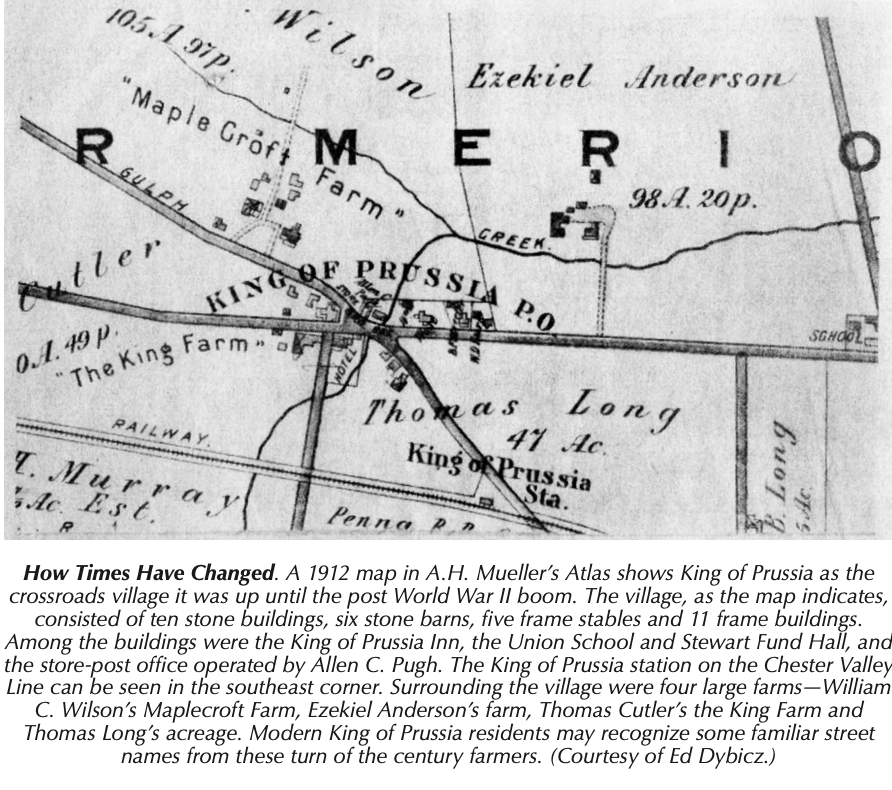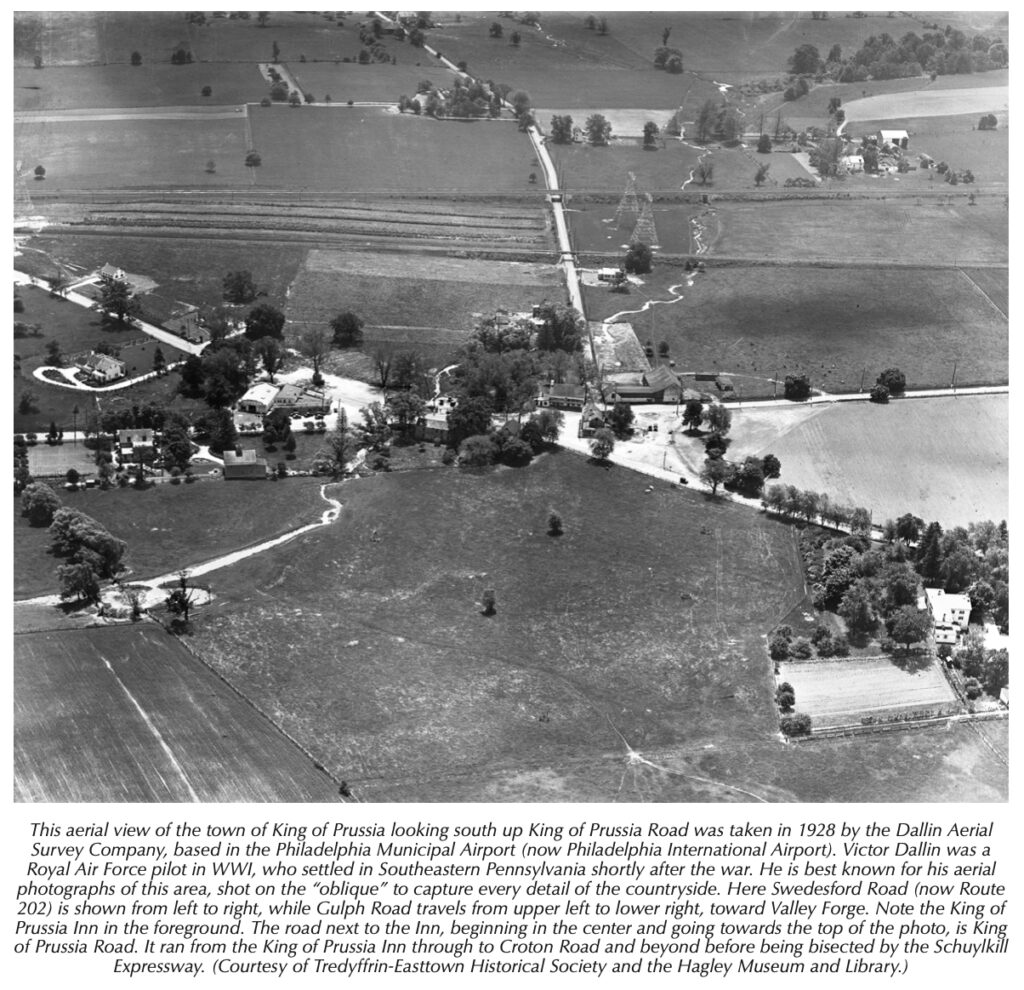1967 Article by Ed Dybicz
An inquiry was received by this column concerning a record of any movement made in the old days to change the name of King of Prussia village in Upper Merion Township. A resident of that area recalls his father mentioning such an attempt.
This question no doubt stems from the recent report that the U. S. Post Office Dept. disapproved a suggestion made by a township resident to have the name of the King of Prussia Post Office changed to Upper Merion to facilitate mail delivery and gain independent status.
The village which is now King of Prussia, around the intersection of DeKalb Pike (formerly known as Swedesford Rd.) and Gulph Rd. (Route 23), was founded in 1819 and was originally called “Reesville”, probably for the Reese Family which resided in that neighborhood, according to records of the Historical Society of Montgomery County.
Seven buildings formed the village. A post office was opened in 1820 with the name of Reesville.
The name “King of Prussia” was adopted for the post office in 1850 from the King of Prussia Inn, which was located at the crossroads of the village since 1769.
King of Prussia is not a pre-revolutionary period village. In 1765 there were only four areas mentioned, they being Swedesford, the largest, (now the community of Swedesburg and Borough of Bridgeport); Matsonford, (now the Borough of West Conshohocken); the Gulf, (now Gulph Mills); and the Forge (Valley Forge).
Technically, the present King of Prussia Post Office Building on Town Center Rd., and Prince Frederick St., is not in King of Prussia, but in the Red Hill section of Upper Merion. The Valley Forge Shopping Center, Valley View Apartments, St. Augustine and Roberts cemeteries are all located at Red Hill.
Many old township villages such as Abrams, Shainline, Henderson, Red Hill, Paradise, and portions of Port Kennedy, Hughes Park, King Manor, Gulph Mills and Swedeland, were placed under the extended postal boundaries of the King of Prussia Post Office in 1958. These have on occasion, been erroneously referred to as King of Prussia or King of Prussia area.
Recently, some persons in Upper Merion were misled to believe that the change of the post office name meant the change of the village name which was not the case.
During World War I, however, super-patriotism of unhistorically minded critics demanded the abandonment of the name of the King of Prussia Inn, because the United States was at war with the Prussians (Germany).
Propaganda depicting cruelties by the despotic militarism and harsh discipline of the Prussian ruling classes fanned the flames for a name change.
So great was the pressure exerted that owners of the tavern changed the name to “YE OLD KING INN”.
Records of the Norristown Daily Herald reveal that in August of 1919 a proposal was made to change the name of the village of King of Prussia, and have it annexed to its neighbor, Port Kennedy.
At that time, the Valley Forge Park Commission was appropriated some $250,000 for condemnation purposes in acquiring more ground for the State Park, and this almost destroyed the village of Port Kennedy, as many homes and business places were razed for the expansion.
The pacification movement then turned to have the remaining portion of Port Kennedy, and the annexed village of King of Prussia, merged to form the one large community of Port Kennedy.
One newspaper account read, “The people asked to consider the name change of King of Prussia because of the resemblance of the name to that of a recent warring country and to change the name to Port Kennedy, which is more suitable.”
(Today, the King of Prussia Industrial park is extensively located in Port Kennedy).
After defeat of Germany, and when tempers subsided, the original name of King of Prussia Inn was again adopted. The old name of the village was not altered, and thus, has survived.
It is interesting to note in A. H. Mueller’s Atlas the growth of King of Prussia village in 1912.
At that time the village had 10 stone buildings; six stone barns, five frame stables, one hotel, one school, one brick building, 11 frame buildings, and a combination store – post office conducted by Allen C. Pugh.
King of Prussia village was surrounded by four large farms, they were, William C. Wilson’s 105 acre “Maple Croft Farm”, Ezekiel Anderson, 98 acres, upon one corner was located Stewart Fund Hall; Tomas Cutler’s 80 acre “The King Farm”, and Thomas Long’s property containing 47 acres.
Most recent objection to an attempt to place the name of “King of Prussia” to an area away from the village occurred several years ago when Upper Merion School Directors voted to name a new school on Caley Rd., Abrams, “King of Prussia Elementary School”.
Letters opposing the name “King of Prussia” to the school were sent by many old families of the township, including descendants of the Caley and Abraham families, early distinguished settlers of the Abrams area. The School Board reconsidered and decided to call its new school the “Caley Rd. Elementary School.”


